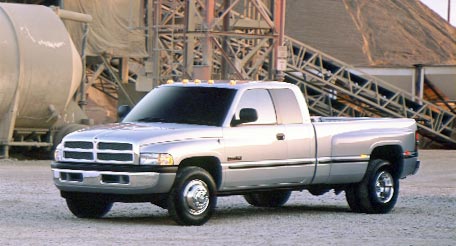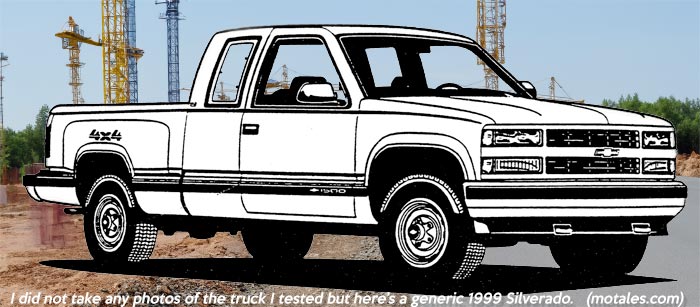Back in 1999, I test drove, back to back and for a week each, all three American Class 2 pickups—the Dodge Ram 2500, Chevrolet Silverado 2500, Ford F-250—and a Toyota T-100 for comparison. How did they rate?

First, all three American automakers had an eight foot bed and high towing capacities. They also had quite stiff suspensions, lousy gas mileage, lots of wind noise, and poor handling compared to sedans or light-duty pickups. They came with five-speed transmissions; manual transmissions were still available at the time, though not universally.
GM made the most popular pickups then and now; in 1999, they were busily upgrading their venerable 305, 350, and 454 V8s to their Vortec technology, similar to Ram moving to Magnum engines. The Silverado name, incidentally, was new then as a catch-all for their pickups; before then, they referred to their C/K series (C for rear wheel drive, K for four wheel drive.) Buyers could also get a V6 engine even in the 2500, or a diesel. The main upgrade of the Vortec, if 1999 me was to be believed, was in fuel economy; the prior year’s engines had been competitive with Ford in power but were less efficient. (Vortec engines used better-tuned intake manifolds, new cam profiles, roller lifters, sequential fuel injection, and platinum-tipped spark plugs; the name likely referred to the high-swirl, fast-burn combustion chambers in the new heads.) GM had also recently switched over to a bus electrical system, at roughly the same time as the Jeep Grand Cherokee.

The diesel engine was a $3,000 option; it had a moment with the glow plugs, then started right up with a nice growl. It was loud at idle, louder still at highway speed. I liked the smooth automatic, which seemed adpet at picking gears, much more than the 16 mpg fuel economy on mostly highway driving. Gearing was likely a large part of the culprit, but at least the pulling power was strong at any speed and acceleration was constant and steady. Engine power was good from idle to the 3,500 rpm redline. The normal 7.4 liter V8 produced 290 hp and 410 lb-ft of torque; the 5-liter produced 230 hp and 285 hp; and the 5.7 was good for 255 hp and 330 lb-ft of torque. The diesel was rated at 180 hp and 360 lb-ft of torque for vehicles rated below 8,600 lb and 195 hp and 430 lb-ft for heavier-duty vehicles.
As with the other pickups, I tried to load of the bed as much as I could, and found it made no difference except to smooth out the ride somewhat.
This may be the review I remember most vividly, including such cars as Corvettes, the Saturn Sky, a wide range of Mopars, Lexus performance cars that could keep up with the Corvettes (in a straight line)—beacuse the dang thing was so large. The crew cab, extended length bed, and heavy duty “duallie” four rear wheel towing package made parking an adventure; it didn’t fit into the lanes on Route 287 or Route 80, which was much of my 58-mile commute, much less State Route 202. What's more, the truck didn’t fit lengthwise or widthwise into my driveway; if I nudged the bumper against my garage, the rear bumper only stuck out a little into the street. The wheels neatly sat on the grass on either side of the driveway.
When the part-time 4xe was engaged, as with any vehicle with that system, turning around took up two more lanes; but even normally, the size of the truck meant that the turning radius was a full lane wider than with cars.
The interior was nicely appointed, and the gauges were clear and readable in that wonderful, unostentatious 1990s fashion. Other than the overloaded GM stalk which combined cruise control, turn signals, and wipers, controls made sense. The console between the seats was a copy of the one pioneered by the earlier Ram 1500, and it had a storage area and pad holder, but wasn’t quite as clever as the Ram’s. The six-way power seat was a nice touch.
The ride was stiff and jittery due to the heavy duty towing suspension; it improved under a heavy load. In all honesty, overall, this was probably tied with the Ram for my “best truck” evaluation—but the diesel made a big difference. It was also the only truck I didn’t take to work every day that week, because, well, it didn’t fit on the road.
Ford was already calling their heavy duty trucks “Super Duty” despite being officially classed as medium duty (all the “heavy duty” 2x0x/3x0x pickups are medium duty). It was the best selling truck from a single brand, GM splitting their sales between Chevrolet and GMC. Its new V8 engines were a modern design which made their power at higher revs, and produced better gas mileage than past engines. They also had a new V10 option to match Dodge, and a diesel with a hefty 500 lb-ft of torque. Ford could then out-tow their Dodge counterparts.
The new F-series pickups were radically different from the older models, with new suspensions and basic body designs; and they were joined by heavier-duty F-450 and F-550 pickups, with chassis cab versions for making into all manner of dedicated trucks. Their crew cab chassis cabs at that point were unique. The interior was an excellent copy of the Dodge Ram interior; they had learned well (indeed, they were clever enough to avoid copying Dodge’s oddball climate controls). The cab was roomy and well-designed. The hood was less convenient than the Dodge, which included side openings; the rear had an excessively heavy gate. To Ford’s credit there was little wind and road noise. The seat belts were clever but hard to use.
Our test car had the gasoline V-10 engine, which was well behaved and quite good at moving the heavy truck, albeit not quite as powerful as the big and thirsty Dodge V-10. We averaged around 13 mpg in highway driving and 8 mpg in the city, which was fairly terrible compared with the Chevy diesel. The transmission seemed to want to shift softly. The ride was less firm than the Dodge’s, which is a compliment, but with no load, it jounced about the road even more than the Ram. Putting in a heavy load quieted it down a bit.
The award for “most disappointing pickup” went to the Toyota, an oddly expensive V6-driven pickup with surprisingly poor mileage of around 16 mpg in mostly highway driving. Keep in mind this truck was the only one to be in the lower duty class. The engine was peppy but without much torque, and hitting the gas often brought a downshift as the engine surged to the redline; transmission action was frequent on the highway.
Wind noise was the worst of the four trucks, and the windshield was a superb bug catcher, sitting nearly straight up. Aerodynamics in this pickup were poor. Visibility was excellent, though, with much better focused, brighter headlights. The instrument panel was clear but the profusion of stalks was a bi nuts. The ride was relatively pleasant and luxurious. The cupholder, incidentally, was placed over the stereo, so that a cup of fast-food water (or soda) would drip condensation into the tape deck in a design unworthy of Toyota.
A V-8 powered pickup dubbed the T-150 was announced for later that year, but too late to be tested.
The Dodge Ram 2500 was still sold with the 318 and 360 V8s as well as the 3.9 liter V6 and 488 cubic inch (8 liter) V10, both of which were based on the V8s. The brakes were not quite as good as the other trucks’ were. Our test car used the V10, a $1,000 option; the Cummins diesel was a $3,000 option, but Cummins claimed their engines could go for 400,000 miles before their first overhaul.
The V10 was quiet, smooth, and always ready; this was not the Viper tuning, but the one meant for trucks, so it was quite torque biased. It could easily brake the rear tires loose under part throttle but could be driven tamely. We averaged around 12 mpg in mostly highway driving, which was even worse than the Ford V10; the Cummins would likely have given us another 6-10 mpg. The automatic shifted firmly and felt tight; it seemed to be tuned for responsiveness rather than fuel economy, not shifting up as quickly as the others did. The transmission computer predicted our needs well.
Traction was surprisingly good; rough roads didn’t hurt handling much, despite considerable jouncing when unloaded. The engine was quiet but the exhaust and wind were both fairly loud. The Ram felt more comfortable than the Chevy on rough roads, but didn’t feel as tight and bounced around more; carrying even a light load, though, smoothed it out surprisingly well. As with the Chevy and Ford, the 4x4 system, which elevated the truck a little more, probably hurt a bit with noise and bounce.
The interior was clearly designed for work, even though it could seat six in a pinch. The gauges and controls were largely well laid out, the climate controls not so much. the exterior was the best looking of the group.
Copyright © 2021-2025 Zatz LLC • Chrysler / Mopar car stories and history.
YouTube • Editorial Guidelines • Videos